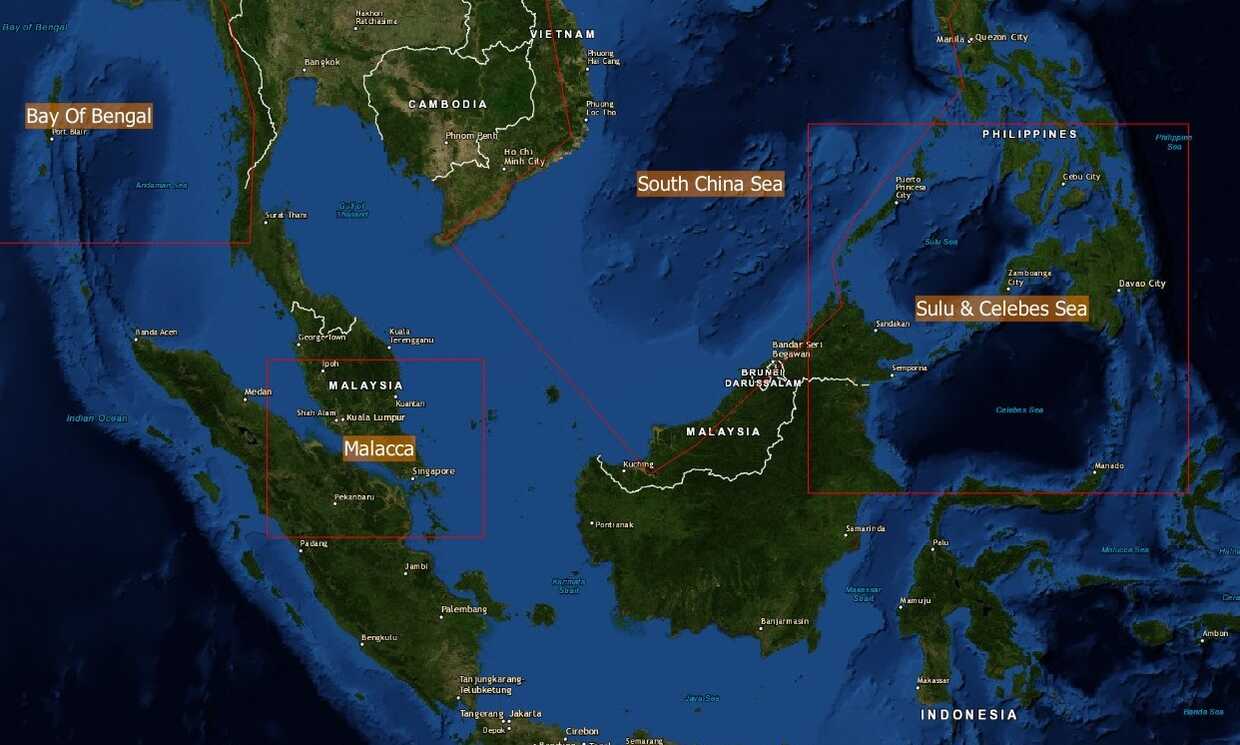Any one who has even superficially followed US-India relations knows that this relationship follows a 2-steps forward, 1-step backward path. US-India relationship, at least the geostrategic component, reached its recent zenith in second half of 2020. Faced with blatantly invasive Chinese actions in India’s Ladakh province, the Trump Administration firmly, publicly, & institutionally supported India’s stance & built an even firmer US-India strategic partnership.
The US determination to face up to China reached its public high when US Navy Secretary Kenneth Braithwaite declared:
- “We want to stand up a new numbered fleet. And we want to put that numbered fleet in the crossroads between the Indian and the Pacific oceans, and we’re really going to have an Indo-PACOM footprint,”
Where is the critical crossroad, or more correctly the cross-strait? Look at the map below and see the red square in the middle that links the South China Sea & the Australasia body of water to the red square on the left titled Bay of Bengal. The middle square is titled Malacca after the critical Straits of Malacca. Remember the old Portuguese dictum – whoever controls Malacca controls Venice.
How does the US Navy operate in this large & critically interconnected body of water? Via the 7th Fleet based in Japan and the 5th Fleet based in Bahrain. Woefully inadequate as most can realize. Hence the urgency for creating a new numbered fleet to be based in or have responsibility for this vast body of water.
This realization led a couple of years ago to elevate the mindshare of this naval region with a correct but new name Indo-Pacific to replace the older & more restrictive Asia-Pacific.
China, the smart, determined & far-thinking power, reacted negatively to this name change.
- Brahma Chellaney@Chellaney – China’s state media has been urging Biden to replace “Indo-Pacific” with “Asia-Pacific.” Biden obliged while nominating Lloyd Austin as secretary of defense (j.mp/2VXIgIT). Also, China must be pleased that Biden hasn’t mentioned the Quad — before or after the election.
Even maniacal Hitler did not want to get caught in a two-front conflict. The far smarter China doesn’t either. The term Indo-Pacific seals in the partnership with Indian Navy & the US Navy thus exposing the Chinese military & commercial fleet to a dangerous two-front challenge. China prefers the US Navy to be isolated to the Pacific where China is itself strong and not in the Indian Ocean where Indian Navy is strong & the Chinese Navy is trying to build its presence.
So you can see why the term Indo-Pacific has become a major symbol of US focus & determination. With that has come the Quad, the four-way naval relationship between USA, India, Japan & Australia. It is critical for China & its plans to stop all this & restrict the US back to the Pacific region.
So guess what Mr. Biden did this week while nominating General Austin as his Secretary of Defense. He went back to the Obama era Asia-Pacific term instead of the Indo-Pacific term & he didn’t even mention the Quad. And Mr. Biden did the same in his article in the Atlantic magazine titled Why I Chose Lloyd Austin as Secretary of Defense. Everybody noticed:
- Ashley Townshend@ashleytownshend – – With all due respect for the critical issues raised in this letter, Biden’s failure to mention China or the Indo-Pacific strategic landscape in his justification of SECDEF pick Austin will be viewed with great concern by allies and partners in the region.
And this has impact on Europe as well.
- Theresa Fallon@TheresaAFallon – – Just when the Europeans, after a great deal of deliberation, started to use the term Indo-Pacific
This is, of course, par for the course for the Indian foreign policy & defense establishment. It has gone on for the past four US Presidential changes. President Clinton had literally no use for India until very late in his second term. President Bush was much more far-sighted and he took the US-India relationship to a much higher level. Then came President Obama with his conviction that Bush had tilted the “balance” way too much in favor of India. His campaign advisors were firm on restoring the balance in favor of Na-Pakistan.
Then came Trump. Frankly, he didn’t care at all about India. He, like Bush, simply thought that US needs India if US is going to firmly oppose Chinese expansion. So the Trump Administration focused on the geo-strategic & military aspects of the US-India partnership and it grew broader & deeper.
Now comes the Biden team, a team that above all wants to rebuild an amicable relationship with China and a team that is intrinsically anti-Hindu and pro-Pakistan just as the Obama team was. Everybody sees this, especially Russia. No wonder this week Sergei Lavrov, the veteran Russian foreign minister, blamed America for the recent troubles between China & India. Russia needs India badly to balance Russia’s own relationship with China, a relationship that is slowly turning Russia into a subordinate partner to China. And Russia needs India as a major customer of Russian military equipment.
And there is a deep reservoir of pro-Russia feelings in India. After all America has been anti-India and pro-NaPakistan for nearly 70 years while Russia has been a friend & supporter. This faction in India had grown silent with the vocal & material support from the Trump Administration for India against China. Now they can resurface with the old argument that America is just not to be trusted as a long-term partner.
The long term Indo-US trajectory will not change. After all even the Obama Administration came around. But it did take Obama 6 years to begin rebuilding what his team had broken in 2008. How long might it take the Biden team to get positive on the Indo-US relationship? As long is it takes them to understand the importance of Indo-Pacific.
Send your feedback to editor@macroviewpoints.com Or @MacroViewpoints on Twitter
